The following is a standard order of battle of the Polish cavalry brigade in 1939.
The following is a standard order of battle of the Polish cavalry brigade in 1939.
| Sub-unit | C/O | squadron-sized | platoon-sized | smaller units | |
| commanding officer | Staff and headquarters | deputy commanding officer chief military judge chaplain | |||
| chief of staff | operational officer intelligence officer | military police platoon | |||
| chief communications officer | communication squadron | ||||
| chief commander of the tabors | tabor's workshop 2 commands of march columns | 3 columns each | |||
| quartermaster | transport officer armament officer chief steward officer chief doctor chief veterinarian | artillery park unit steward park unit medical platoon veterinary platoon | |||
| Headquarters commander | staff squadron | ||||
| Commander's units | bicycle squadron (recce/liaison) engineering squadron | HMG platoon | |||
| cavalry regiment 3 or 4 in each brigade | regiment commander | line squadrons - 4 in each regiment | cavalry platoon - 3 in each squadron | 3 sections (6 soldiers each) LMG section (5 soldiers) squadron commanders troop | |
| LMG section administration unit | |||||
| HMG squadron maintenance squadron | 3 HMG platoons | 4 HMG each | |||
| AT platoon bicycle platoon communications platoon | engineering squad | ||||
| Mounted Artillery Unit (DAK) | DAK commander | munitions supply column | 75 mm artillery battery 3 or 4 guns each | ||
| communications platoon | |||||
| Organic Armoured Unit | commander | tankette squadron armoured car squadron | |||
| Organic Rifle Battalion | Rifles battalion | ||||
The following is a list of all equipment, armament, men and means of transport in use by a cavalry regiment and a cavalry brigade of the Polish Army, as of 1939. The figures for brigades are based on official Polish Army instructions prepared in late 1930s. The numbers in brackets give the figures for a four-regiment brigade, as opposed to the standard three-regiment one. The figures for the regiments are given after the actual mobilisation report of September 1, 1939, of the 25th Greater Polish Uhlans Regiment. Note that the numbers for other units may vary, mostly due to different mobilisation schedules and other problems. [1]
| Regiment | Brigade | ||||||||||||
|---|---|---|---|---|---|---|---|---|---|---|---|---|---|
| General | |||||||||||||
| officers | 36 | 232 (373) | |||||||||||
| privates and NCOs | 838 | 5 911 (6 911) | |||||||||||
| horses Cavalry horses Pack horses Cart-horses Total | 616 43 221 920 | 5 194 (6 291) | |||||||||||
| Vehicles | |||||||||||||
| cars | 1 | 65 (66) | |||||||||||
| motorcycles | 1 | ||||||||||||
| field kitchens | 6 | ||||||||||||
| tabor carts | 86 | ||||||||||||
| chaplains cart | 1 | 4 | |||||||||||
| taczanka wz.28 or wz.36 | 13 | ||||||||||||
| bicycles | 36 | ||||||||||||
| Armament | |||||||||||||
| Vis pistols | 133 | ||||||||||||
| wz. 34 sabres | 616 | ||||||||||||
| lances | 108 | ||||||||||||
| rifles Mannlicher 1888, Kbk wz. 1929, Kb wz. 98a, Mosin wz. 91/98/25, Kbk wz. 91/98/23 or Steyr-Mannlicher M1895 | 740 | 5000 | |||||||||||
| 7,92 mm karabin ppanc. wz 35 AT rifle | 12 | 51 (64) | |||||||||||
| rkm Browning wz. 28 LMG | 18 | 89 (107) | |||||||||||
| Maxim 08/15 and lkm wz. 08/18 MGs | 10 (12) | ||||||||||||
| Ckm wz.30 HMG | 12 | 52 (64) | |||||||||||
| Organic artillery | |||||||||||||
| grenade launchers wz. 1930 and wz. 1936 | 9 (9) | ||||||||||||
| 81mm mortar wz. 31 | 2 | ||||||||||||
| 75 mm Armata 75 mm wz.02/26 field gun | 12 (16) | ||||||||||||
| 40 mm armata plot. wz. 36 AA gun | 2 (2) | ||||||||||||
| 37 mm Armata ppanc. wz. 36 AT gun | 4 | 14 (18) | |||||||||||
| Organic armoured unit | |||||||||||||
| wz. 34 or wz.29 armoured car | 8 | ||||||||||||
| reconnaissance tankette TKS or TK-3 | 13 | ||||||||||||
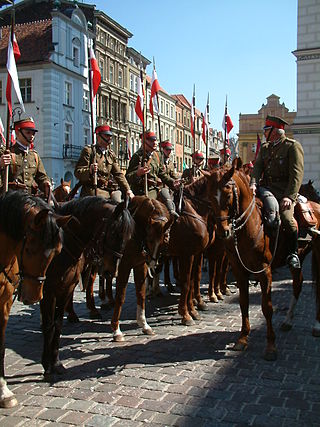
The Polish cavalry can trace its origins back to the days of medieval cavalry knights. Poland is mostly a country of flatlands and fields and mounted forces operate well in this environment. The knights and heavy cavalry gradually evolved into many different types of specialised mounted military formations, some of which heavily influenced western warfare and military science. This article details the evolution of Polish cavalry tactics, traditions and arms from the times of mounted knights and heavy winged hussars, through the times of light uhlans to mounted infantry equipped with ranged and mêlée weapons.

Operation Tempest was a series of uprisings conducted during World War II against occupying German forces by the Polish Home Army, the dominant force in the Polish resistance.
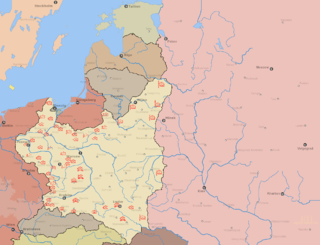
This article discusses the Polish order of battle during the invasion of Poland. In the late 1930s Polish headquarters prepared "Plan Zachód", a plan of mobilization of Polish Army in case of war with Germany. Earlier, the Poles did not regard the Germans as their main threat, priority was given to threat from the Soviets.

The Land Forces are the land forces of the Polish Armed Forces. They currently contain some 62,000 active personnel and form many components of the European Union and NATO deployments around the world. Poland's recorded military history stretches back a millennium – since the 10th century. Poland's modern army was formed after Poland regained independence following World War I in 1918.

The 10th Cavalry Brigade was a Polish military unit in World War II. It was the only fully operational Polish motorized infantry unit during the Invasion of Poland, as Warsaw Armoured Motorized Brigade was not completed by September 1, 1939.
Kraków Army was one of the Polish armies which took part in the Polish Defensive War of 1939. It was officially created on March 23, 1939 as the main pivot of Polish defence. It was commanded by Gen. Antoni Szylling. Originally, Kraków Army was to be made of seven infantry divisions, two cavalry brigades and one mountain brigade. On September 1, 1939, General Szylling had the force which consisted of five infantry divisions, two cavalry brigades and one brigade of mountain infantry. Altogether, the army was made of 59 battalions, 29 squadrons, 352 cannons, 90 tanks, two armoured trains and 44 planes. These forces were not enough to halt German advance, especially in the area north of Częstochowa, where Kraków Army connected with Łódź Army. Main thrust of Wehrmacht panzer units was directed there, and this area was defended only by the Polish 7th I.D., which was destroyed in the early days of September 1939, opening the way towards central Poland.

The 7th Infantry Division was the name of several units of the Polish Army.
The 8th Infantry Division was a tactical unit of the Polish Army. It was active in the Polish-Bolshevik War, as well as during the Invasion of Poland in 1939. During World War II, the division was reformed twice as part of two distinct armed forces: once as part of the Home Army during the Warsaw Uprising and again as part of the Polish Army in the East.

Kraków Cavalry Brigade was a unit of the Polish Army, created on April 1, 1937. Its headquarters were located in Kraków, but some units were stationed in other places:

A Dowództwo Okręgu Korpusu was a military district of the Ministry of Military Affairs of the Second Polish Republic. It served as an organizational, mobilisational, and administrative body of the Polish Army and all local military units of the country were subject to the Corps commands. Also, the DOKs ran all Military Draft Offices of Poland. The system of DOKs was modeled after the French Army, and according to Polish planners, each district located along either Soviet or German border was supposed to field one army. It meant that all districts except for District X, were subject to this rule. The borders of the DOKs did not reflect the Administrative division of Second Polish Republic.
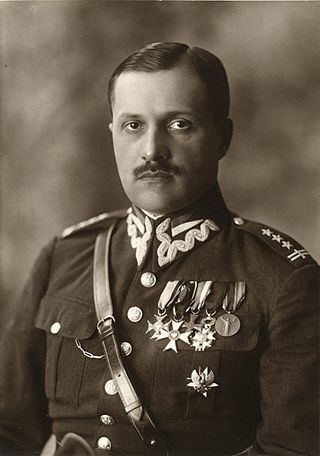
Zygmunt Podhorski was Brigadier General of the Polish Army. Born May 25, 1891, Podhorski fought in World War I, Polish–Soviet War and the Invasion of Poland. Altogether, he served in the military from 1914 until 1946. He died in 1960 in London.

The First Krechowce Uhlan Regiment was a mounted unit of the Polish Army, active in the Second Polish Republic. Its traditions were continued during World War II, by a regiment of the same name, which was part of Polish Armed Forces in the West. 1st Krechowce Uhlan Regiment was formed in 1915, as a unit of the Imperial Russian Army. It fought in World War I, Polish–Soviet War and the Invasion of Poland, as part of Suwalska Cavalry Brigade. Until 1939, the regiment was stationed in Augustów. It ceased to exist in 1947. First commandant of the regiment was a Tsarist officer of Polish ethnicity, Colonel Bolesław Mościcki, who was killed in 1918 near Luninets. Last commandant was Colonel Leon Strzelecki.

The 9th Lesser Poland Uhlan Regiment was a cavalry regiment of the Polish Army, formed on November 21, 1918. Its first commandant was Rittmeister (Rotmistrz) Józef Dunin-Borkowski. The regiment fought in the Polish–Ukrainian War, Polish–Soviet War and the Invasion of Poland. In the Second Polish Republic, it was garrisoned in the towns of Czortków and Trembowla, and in 1939, it was part of Podolska Cavalry Brigade. The 9th Regiment was named after historic Polish province of Lesser Poland.

7th Lublin Uhlan Regiment of General Kazimierz Sosnkowski was a cavalry unit of the Polish Army in the Second Polish Republic and in the Polish Armed Forces in the West. Until 1939, it was garrisoned in Mińsk Mazowiecki. The day of the regiment was on March 23, the anniversary of the decoration of its flag with the Virtuti Militari.

8th Uhlan Regiment of Prince Józef Poniatowski was a cavalry unit of the Polish Army in the Second Polish Republic. Until 1939, it was garrisoned in Krakow, and its traditions dated back to 1784, when a cavalry regiment of Prince Józef Poniatowski was formed in Lwow. The Prince Poniatowski Regiment was part of the Imperial Austrian Army, and in the early 20th century was called 1st Regiment of Austrian Uhlans. Nevertheless, it was made of ethnic Poles, with Polish officers and Polish traditions. In late 1918 it was renamed into 1st Land of Krakow Uhlan Regiment, and after a few years it was renamed again, into 8th Uhlan Regiment of Prince Jozef Poniatowski.
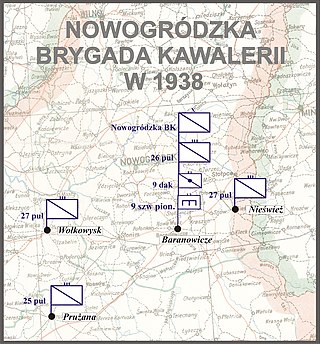
The 27th King Stefan Batory Uhlan Regiment was a cavalry unit of the Polish Army during the Second Polish Republic. Formed in July 1920, it fought in the Polish-Soviet War and the 1939 Invasion of Poland. The regiment was garrisoned first in Wloclawek, to be moved in August 1921 to Nieswiez. In 1939, it was part of the Nowogrodzka Cavalry Brigade. It fought in several battles in September 1939, capitulating to the Red Army near Wladypol, on September 27, 1939.
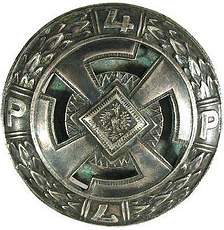
Fourth Legions Infantry Regiment (Poland) was an infantry regiment of the Polish Legions in World War I (1915–1917) and the Polish Army in 1918–1939. During the interbellum period, it was garrisoned in the city of Kielce, and was part of the 2nd Legions Infantry Division.
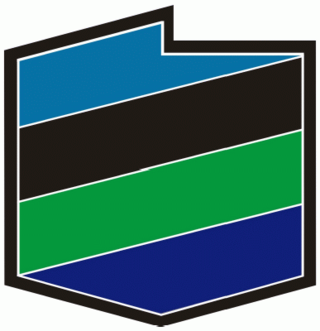
The Armed Forces General Command is a joint command of the Polish Armed Forces, responsible for the combat training and readiness, supply, personnel and technical complement of military units of the armed forces during peace and crisis. It holds administrative command of the units, which are transferred under the operational control of the Armed Forces Operational Command. The current General Commander is Lt Gen Wiesław Kukuła (pl). It is subordinated to the Chief of the General Staff.
The Warsaw Military District was one of three military districts in Poland, the other two being the Pomeranian Military District and the Silesian Military District. It was the regional executive body of the Ministry of National Defense of Poland in the capital of Warsaw in operational and defense matters and military administration existing from 1945 to 1998.